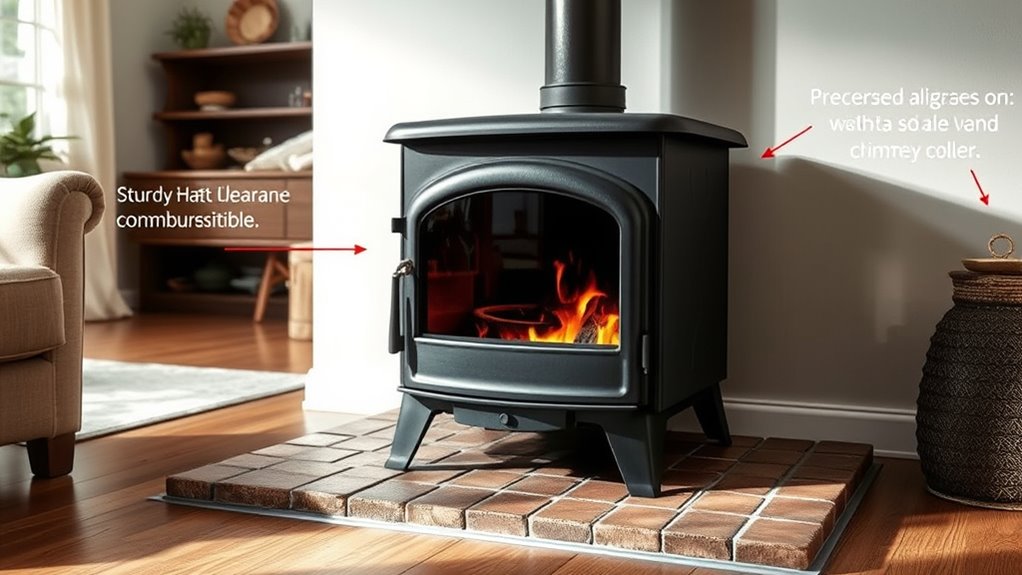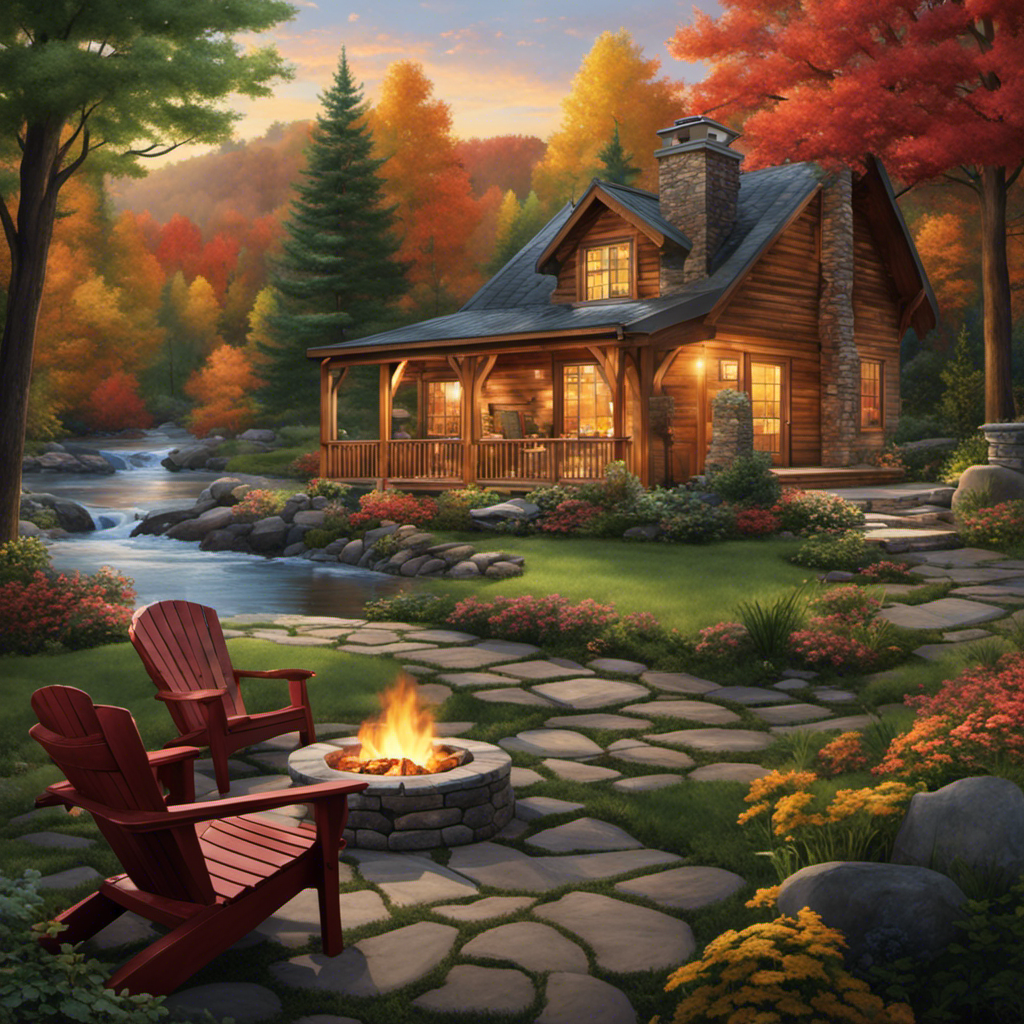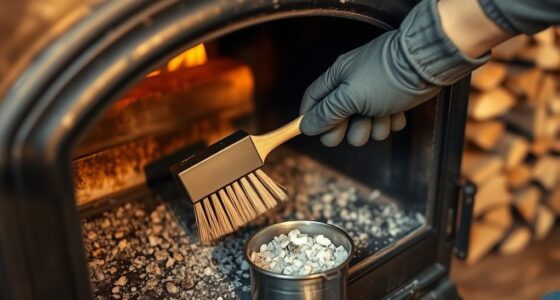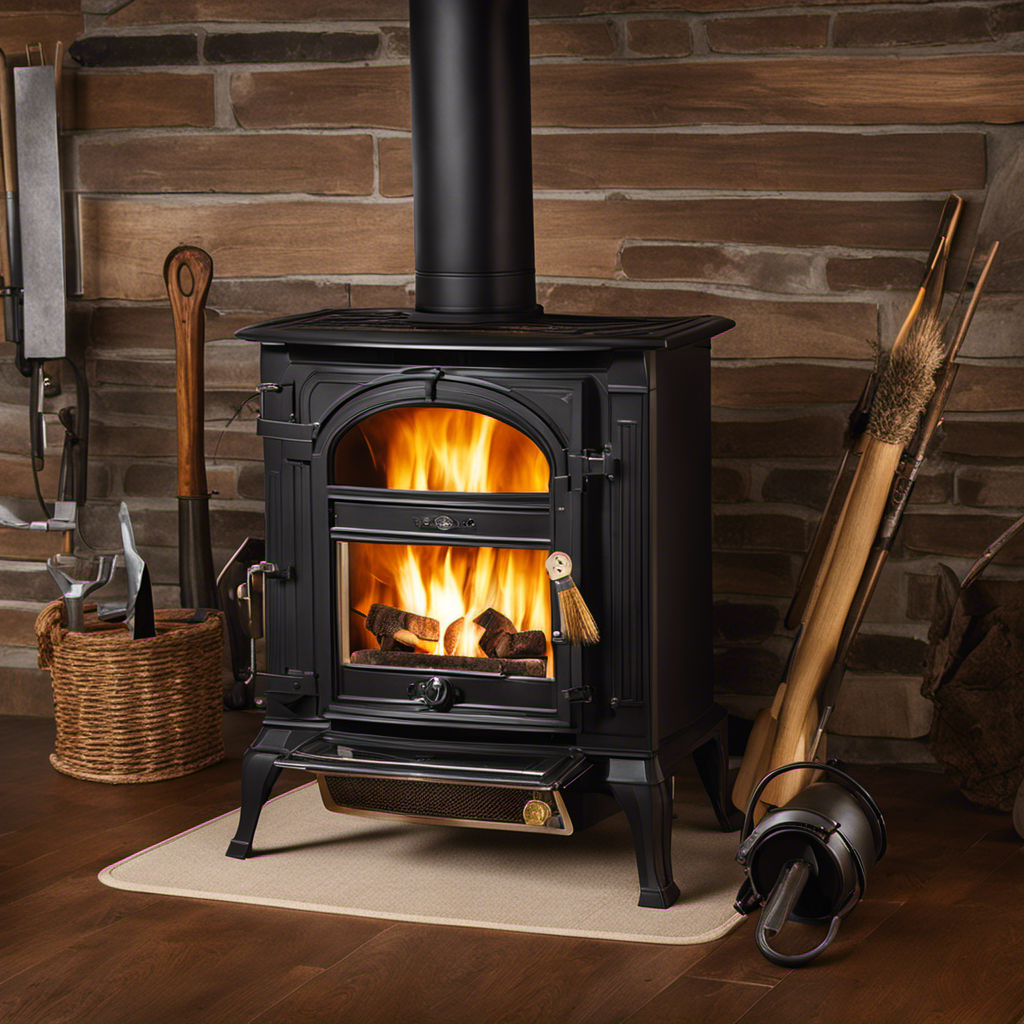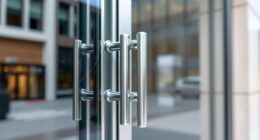When installing a wood stove, make certain to keep at least 36 inches of clearance from combustible materials and properly vent the system outside to guarantee safety. Secure and seal your chimney connections to prevent leaks, and always check local building codes for compliance. Use well-seasoned firewood and avoid improper lighting techniques. Regular maintenance and planning for future upgrades also help prevent hazards. Continue exploring to learn more about avoiding common mistakes and ensuring a safe setup.
Key Takeaways
- Ensure at least 36 inches of clearance from combustible materials to prevent fire hazards.
- Properly seal and inspect chimney connections to prevent leaks and creosote buildup.
- Follow local building codes and obtain necessary permits before installation.
- Use well-seasoned, dry firewood and avoid burning inappropriate materials like plastics or treated wood.
- Regularly clean and maintain vents, stovepipes, and chimneys to ensure safe airflow and prevent fire risks.
Failing to Ensure Proper Clearance and Ventilation
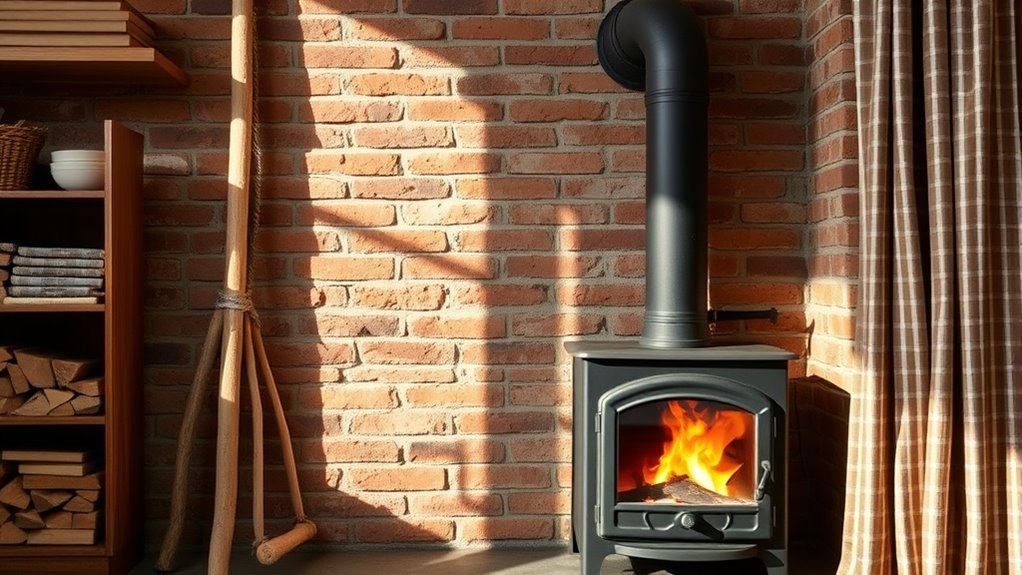
Failing to guarantee proper clearance and ventilation can considerably compromise your wood stove’s safety and efficiency. You should maintain at least 36 inches of clearance between the stove and combustible materials, as recommended by manufacturers and local codes. Proper ventilation is essential for good airflow, ensuring complete combustion and preventing dangerous gases like carbon monoxide from accumulating inside your home. If vents or stovepipes are blocked or improperly sealed, it can lead to poor draft and increased creosote buildup in the chimney, raising fire risks. Insufficient clearance around vents and pipes can cause heat accumulation, risking damage or fire. Regularly inspecting and cleaning ventilation pathways helps maintain proper airflow, reducing hazardous fumes and potential fire hazards. Ensuring adequate airflow is vital for optimal stove performance and safety. Proper clearance and ventilation are critical for safe, efficient operation. Additionally, incorporating ventilation maintenance and ensuring vents are free of obstructions further supports safe stove operation and reduces fire hazards. To optimize safety, always follow manufacturer guidelines for clearance and ventilation standards, and consult local codes to ensure compliance. Being aware of the chemical reactions involved in proper venting can also help prevent buildup of dangerous combustion byproducts.
Neglecting Secure and Sealed Chimney Connections
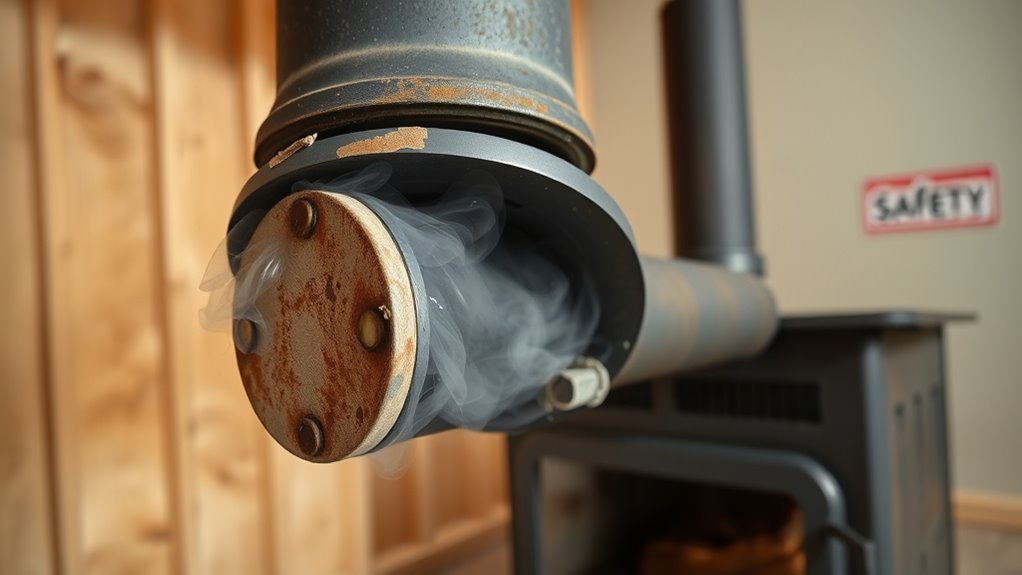
Neglecting to secure and seal chimney connections can lead to serious safety hazards and reduce your stove’s efficiency. Loose or improperly sealed joints create chimney leaks, allowing dangerous gases like carbon monoxide to escape into your home. Gaps or cracks in sealing joints hinder proper draft and can cause smoke and toxic fumes to enter your living space. Using the wrong sealant or neglecting to perform regular chimney inspection can accelerate creosote buildup, increasing the risk of chimney fires. Proper sealing with high-temperature, sealant-rated materials ensures a tight connection that prevents leaks and maintains peak performance. Regular inspection and maintenance of sealed connections are essential to detect and fix issues early, protecting your home and ensuring safe, efficient operation. Additionally, understanding the importance of chimney draft helps maintain optimal airflow and prevents dangerous build-up of combustion gases. Ensuring your support hours are aligned with regular maintenance schedules can help you stay on top of inspections and repairs. Maintaining proper sealing techniques is key to avoiding costly repairs and ensuring the longevity of your wood stove system. Moreover, utilizing appropriate sealants designed specifically for high temperatures can greatly improve the durability of your seals. Recognizing the role of cybersecurity vulnerabilities in modern systems underscores the importance of secure connections and regular checks.
Installing Without Checking Local Building Codes and Approvals
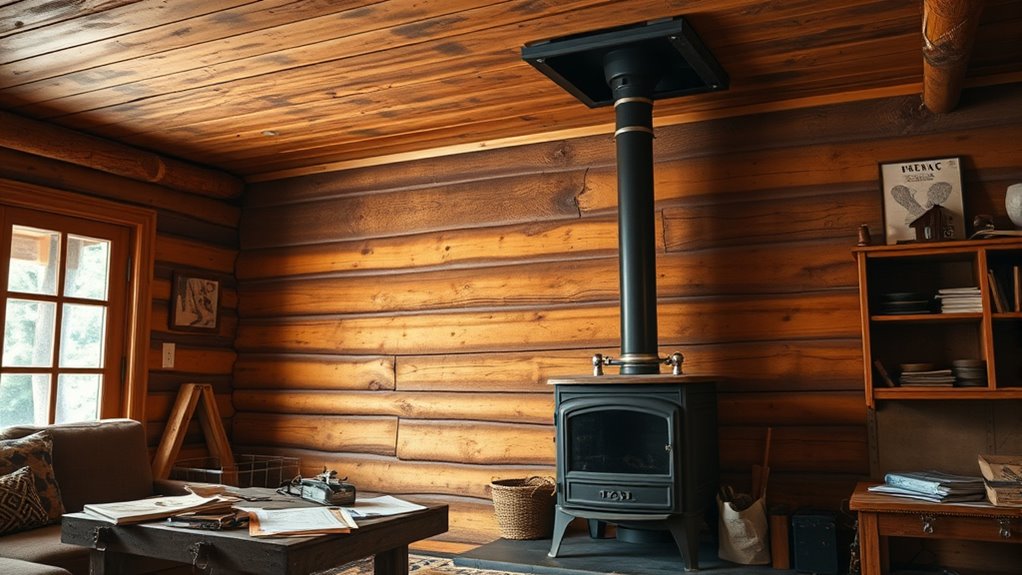
Before installing a wood stove, it’s essential to check your local building codes and obtain any necessary permits. Ignoring these regulations can lead to legal penalties and costly modifications later. Building codes specify clearance distances from walls, ceilings, and combustible materials; failing to meet these standards poses fire risks and safety hazards. Many jurisdictions require permits and inspections to verify that your installation complies with safety standards. Without proper approvals, your insurance coverage could be invalidated if a fire occurs or damage happens. Additionally, neglecting local regulations might cause your installation to be rejected or fined. To avoid these issues, always research your area’s requirements, secure the needed permits, and schedule inspections to ensure your wood stove installation is legal, safe, and up to code. Staying informed about home security systems can also help protect your property during the installation process. Considering building code compliance is crucial for a safe and legal setup. Moreover, understanding fire safety regulations can further reduce risks associated with wood stove use. Familiarizing yourself with regulatory requirements can prevent unexpected complications during installation and ensure long-term safety. Additionally, consulting with a professional installer can help ensure all local safety standards are thoroughly met.
Overlooking the Importance of Correct Firewood Preparation and Storage
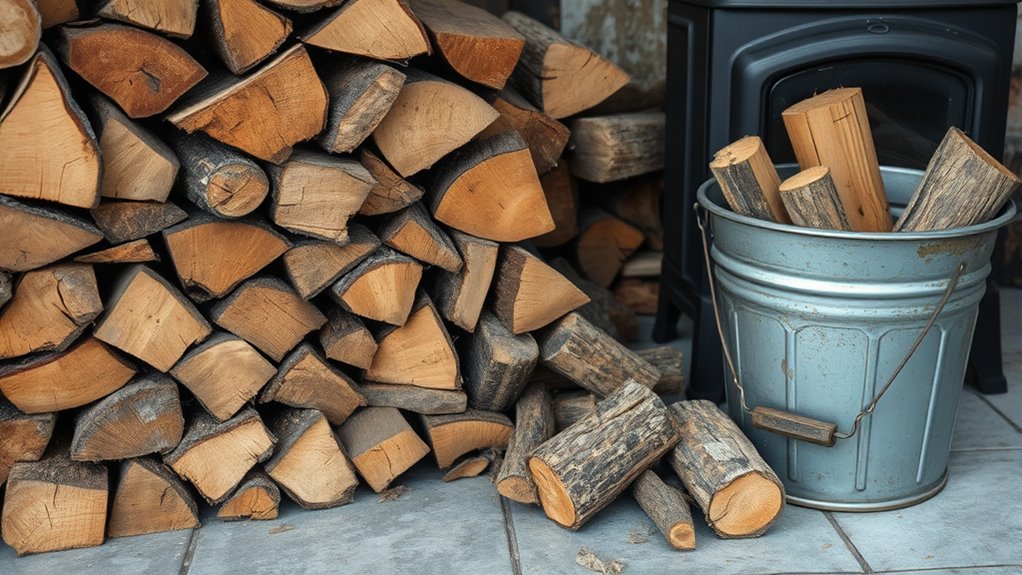
Are you ensuring your firewood is properly prepared and stored? Using well-seasoned firewood with low moisture content is essential for efficient burning. Green wood or freshly cut logs may look ready but contain high moisture, leading to increased creosote buildup, smoke, and soot inside your chimney. Proper drying involves cutting and splitting wood at least a year in advance, then storing it in a way that promotes airflow and protects it from moisture.
Consider these points:
- Store firewood off the ground and covered to prevent absorption of moisture
- Use seasoned firewood with moisture content below 20-25%
- Keep firewood in a dry, well-ventilated area for complete drying
Neglecting firewood storage and preparation hampers your stove’s performance and safety.
Choosing the Wrong Location for Your Stove

Choosing the right location for your stove is essential for safety and efficiency. You need a spot with proper ventilation to prevent dangerous carbon monoxide buildup and ensure good airflow for combustion. Avoid placing the stove too close to combustible materials, as inadequate clearance increases fire risk and violates safety codes. Positioning it where it won’t be in high traffic areas helps prevent accidental bumps or damage. Additionally, locate the stove near existing chimney connections or venting systems to avoid costly modifications and maximize efficiency. Make sure there’s enough clearance for ash removal and maintenance, so cleaning remains safe and straightforward. A well-chosen location minimizes hazards and ensures your stove operates safely and effectively.
Ignoring Regular Maintenance and Chimney Cleaning
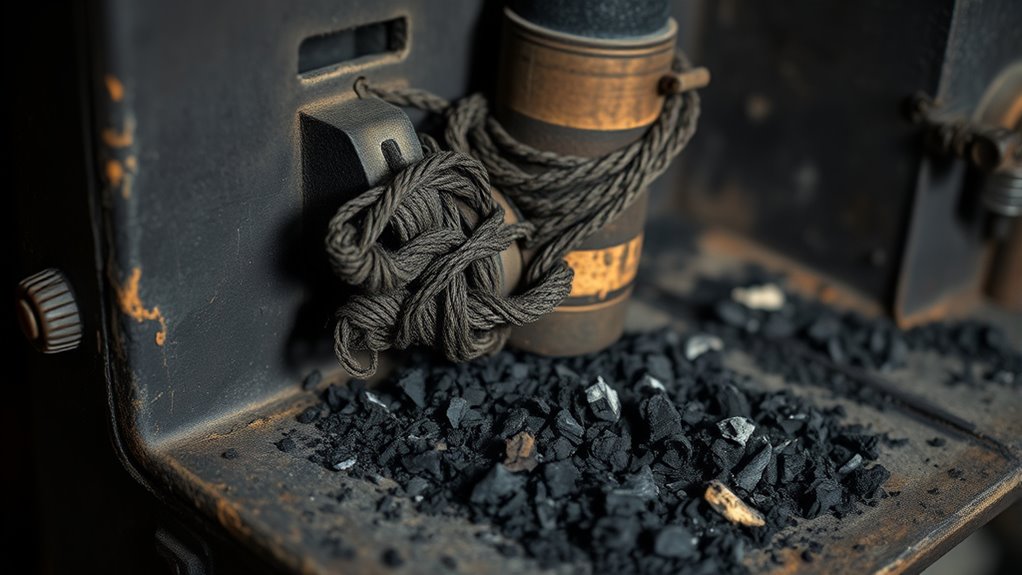
Neglecting regular maintenance and chimney cleaning can lead to serious safety hazards and reduced stove performance. Without routine chimney cleaning, creosote buildup can ignite, risking dangerous chimney fires at relatively low temperatures. Blockages from vent obstructions or debris can cause dangerous carbon monoxide to accumulate inside your home. Soot and debris inside the chimney impede airflow, decreasing stove efficiency and increasing harmful emissions. Additionally, neglecting chimney inspection may hide structural issues or damage to the liner, leading to leaks or safety hazards. Regular inspection and cleaning can help identify issues early and ensure safe operation. Chimney safety is essential for maintaining proper airflow and preventing hazards. Moreover, proper ventilation practices are crucial to ensure that combustion gases are safely vented outside, reducing the risk of indoor air contamination. Understanding dream symbols related to safety and hazards can also help in recognizing potential warning signs in your home environment. Regular maintenance also supports financial aspects by preventing costly repairs or replacements caused by neglect.
Using Inappropriate or Green Fuel for Burning
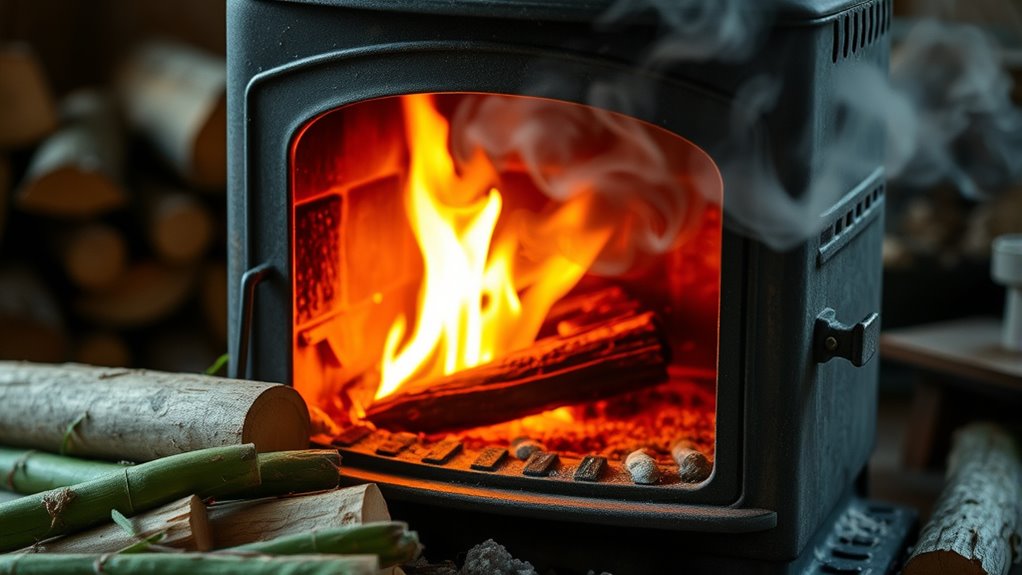
Using the wrong type of fuel can undermine the safety and efficiency of your wood stove just as much as neglecting chimney maintenance. Burning green fuel or unseasoned wood with moisture content above 20-25% produces more smoke, creosote buildup, and poor burn quality. Inappropriate fuels like paper, plastics, or chemically treated wood release toxic fumes and damage your stove. Properly drying firewood in humid areas is essential to reduce moisture levels, improve combustion, and lower pollutant emissions. Relying on fuels not recommended by the manufacturer can cause incomplete burning, increase creosote buildup, and create fire hazards. Additionally, understanding firewood seasoning techniques can help ensure your fuel is properly prepared for safe and efficient burning. Ensuring your firewood is properly seasoned is a key step to fuel quality and maintaining a safe stove operation. Regularly inspecting your fuel for moisture content and choosing the right type of wood can also prevent hazardous emissions. Proper fuel selection not only enhances stove performance but also protects your health and home environment.
Improperly Lighting the Fire and Using Incorrect Accessories
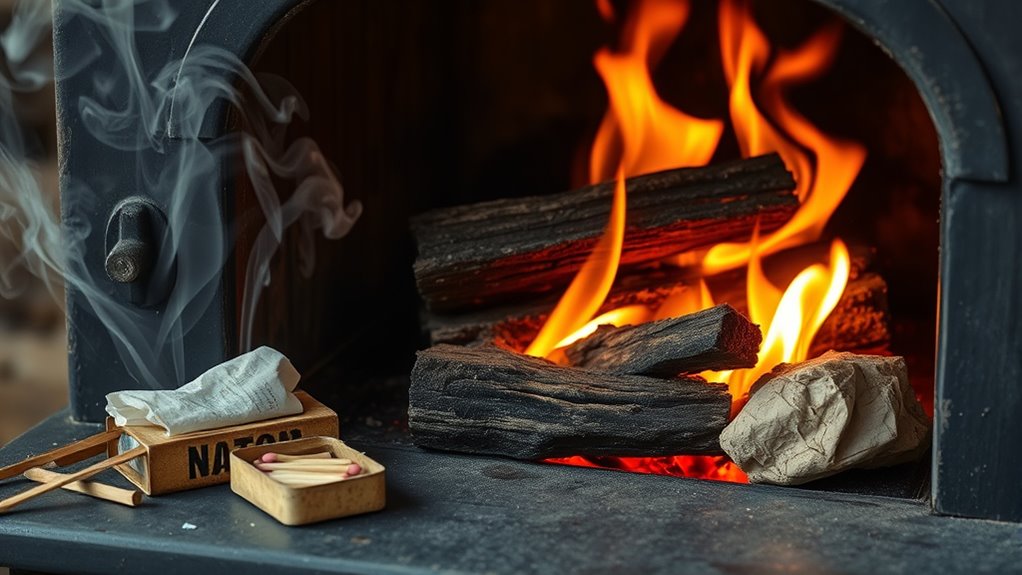
Lighting your wood stove improperly can lead to inefficient burns, increased smoke, and safety hazards. To avoid this, use proper ignition methods, like starting with small, dry kindling placed horizontally in two layers, keeping it clear of stove walls or glass. Make sure the air vents are fully open at first to promote airflow and a strong initial flame. Never use combustible accessories such as paper, chemicals, or flammable liquids, as they can cause flare-ups or damage. Keep the stove door slightly open during lighting until the fire gains momentum, then close it to maintain a steady burn. Additionally, proper ignition techniques are essential for optimal performance and safety. Using the right kind of kindling and fire starters can significantly improve the efficiency of your fire. Avoid shortcuts that involve improper accessories or unsafe ignition techniques, which compromise performance and safety. Proper lighting guarantees a clean, efficient fire every time, and understanding wood stove safety can help prevent accidents.
Not Planning for Future Upgrades or System Compatibility
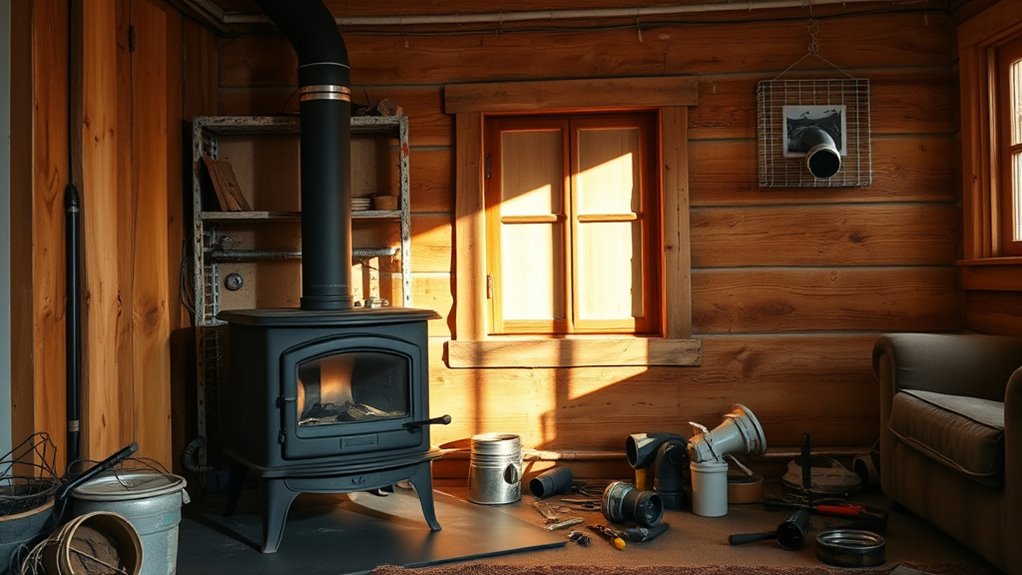
Planning ahead for future upgrades and system compatibility helps prevent costly adjustments down the line. If you neglect to take into account system upgrades, you may face issues with chimney compatibility and clearances, which could require expensive modifications later. Failing to account for future modifications, like adding a catalytic converter or secondary chamber, can limit your stove’s efficiency improvements. Additionally, not designing for future fuel type changes, such as switching from wood to pellet systems, may mean redesigning venting and storage areas. Overlooking the need for modular components can restrict adaptability as technology evolves or household needs change. Always consult building codes and manufacturer guidelines to ensure your system remains compliant and safe during future modifications, avoiding unnecessary headaches and expenses.
Frequently Asked Questions
What Is the 3:2-10 Rule for Wood Stoves?
The 3:2-10 rule guides you to keep at least 3 inches of clearance from combustible materials behind the stove, 2 inches on each side, and 10 inches in front. This spacing helps guarantee proper airflow and prevents heat buildup that could cause fires. Always check your stove’s manual and local codes to confirm specific clearance requirements, as they may vary by model and location.
What Should You Put Behind a Wood Stove?
Think of the space behind your wood stove as a shield wall. You should install a non-combustible material like cement board, brick, or metal panels to safeguard your wall from intense heat. Make sure you maintain the recommended clearance distance, usually at least 36 inches, and ensure proper ventilation to prevent heat buildup. Regularly check for damage, keeping your setup safe and efficient for cozy, worry-free fires.
Will My Home Insurance Go up if I Install a Wood Stove?
When you install a wood stove, your home insurance might go up because of the increased fire risk. To avoid surprises, notify your insurer beforehand, follow all safety guidelines, and guarantee professional installation. Proper clearance, safety features, and adherence to local codes are essential. Doing this helps protect your coverage, prevents claim issues, and keeps your home safe while enjoying the warmth of your new stove.
What Is the Biggest Drawback to Heating With Wood?
Heating with wood can seem like a cost-effective choice, but its biggest drawback is the environmental and health impact. You produce significant particulate emissions, volatile organic compounds, and carbon monoxide, which can harm air quality and your health if not properly managed. Additionally, it requires regular maintenance, proper fuel storage, and ventilation. Without diligent care, you risk creosote buildup, chimney fires, and reduced heating efficiency, making it a labor-intensive option.
What Are the Precautions for a Wood Stove?
When using a wood stove, you should take safety precautions seriously. Make sure to keep combustible materials at the recommended distances, and always install a proper chimney and flue system for safe venting. Use a combustible registration plate to secure the stove, and regularly check seals and connections for leaks. Install carbon monoxide detectors near sleeping areas, and never leave the stove unattended while burning to prevent fire hazards and harmful gas buildup.
Conclusion
By steering clear of these common pitfalls, you’ll turn your wood stove into a warm, reliable heart of your home. Think of it as tending a fire that needs patience and care—neglect and shortcuts can turn a cozy blaze into a smoky, unsteady flame. With proper installation and ongoing maintenance, your stove will glow like a steady beacon, casting comfort and safety over your space for years to come.

